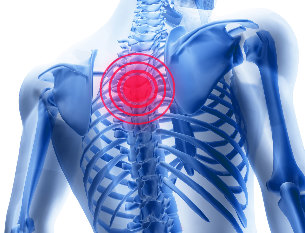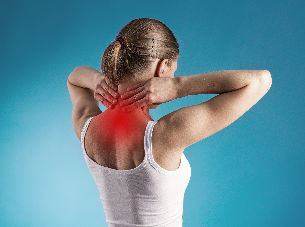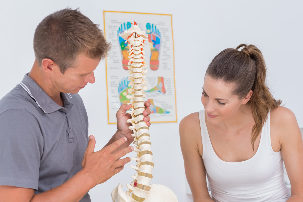Thoracic osteochondrosis – it is a chronic disease that involves a degenerative-degenerative defeats of the intervertebral cartilage disks, which leads to reactive changes from the side of the vertebral bodies and surrounding soft tissues. The disease is pervasive and affects mainly the people themselves in the working age (25-45 years).
Thoracic degenerative disc disease occurs much less frequently than lumbar or cervical. This is due to the fact that this separation of the spine represent less static and motor loads, than on the other. However, osteochondrosis of the thoracic spine is much more difficult to diagnose, because it in most cases takes place by mimicking the disease of the lungs, the heart, the organs of the upper department of a digestive system.

Causes and risk factors
At present, the exact causes for developing thoracic degenerative disc disease is not installed. Experts suggested many theories (infectious-allergic, hereditary, mechanical, hormonal, vascular), but neither one of them does not provide clear and complete explanation of the pathological changes taking place in the spine and lead to degeneration of tissues. It is likely that in the pathological mechanism of the development of thoracic degenerative disc disease at the same time to involved in several different factors. But the main importance belongs to the lengthy static-dynamic the knees of the spinal segment.
The factors, causing such as congestion, are:
- anomalies of the structure of the spine;
- the asymmetrical position of the articular slits in the intervertebral joints;
- congenital narrowing of the spinal canal;
- spondylogenic muscle (myofascial, how it is reflected) and/or somatic (diffuse, arising on a background of a number of diseases of the blood vessels and internal organs) pain;
- the long-term impact on the spine of the vibration, for example among drivers of motor vehicles;
- physical effort;
- obesity;
- smoking;
- sedentary lifestyle (lack of exercise);
- psychosocial factors.
The mobility of the spine is ensured in the intervertebral discs, which also play a and cushioning role. In their center is located an elastic gelatinous core, which in a large number of included water. In osteochondrosis of the nucleus begins to lose water due to demineralization of polysaccharides. Over time, the core flattens and flattens and alone intervertebral disc. Under the influence of mechanical load on the fibrous ring bulges, this process is called projection. Further, in the disk cracks appear, through which fall the fragments of the gelatin core, then is the emergence of a hernia of the intervertebral disc.

Reducing the height of the disc leads to a convergence of the adjacent vertebrae, disorders of the anatomy of the facet joints. It all launches a reactive inflammation in the facet joints and surrounding soft tissues. In addition, the alignment of the vertebral bodies is accompanied by a stretching of the joint capsule, and the affected segment of the spine becomes unstable. The body of the vertebrae of the excessive mobility, which can become a cause of retention of the spinal roots and the development of radicular syndrome.
Background thoracic degenerative disc disease gradually rises bone tissue of the vertebral bodies and form bone growths (osteophytes). They may also become the cause of the radicular syndrome or compression myelopathy (spinal cord compression of the brain).
Classification
On the basis of the classification of thoracic degenerative disc disease lies posindromnoy principle. Depending on what nerve the education of the affected structures of the spine have effect, issue the following syndromes:
- pressure – on the basis of its development lies the tension, the deformation or compression of the nerve root, a section of the spinal cord or blood vessels, depending on which develop spinal, vascular or root syndromes;
- reflective – is associated with a reflective voltage innervated by the muscles, degenerative and vascular disabilities;
- bioadaptive.
Symptoms of thoracic degenerative disc disease
The main feature of thoracic degenerative disc disease, is pain. In most cases, he wears a dull mild in nature.
Long-lasting irritation of the spinal roots becomes a cause of a violation of the innervation of the internal organs. Depending on the level of the lesion thoracic osteochondrosis can flow under the mask of somatic disease:
| The level of the lesion | Innervated by the authorities | Clinical symptoms |
| C7-Th1 | Hands, wrists, palms, trachea, esophagus | Pain in the hands and the palms of the hands, bronchial asthma |
| Th2-Th3 | The heart, pericardium, coronary arteries | Coronary artery disease, cardiac arrhythmias |
| Th4-Th5 | Bronchi, lungs, pleura, the mammary glands, nipples | Bronchitis, pneumonia, pleurisy>[!@#$], bronchial asthma |
| Th5-Th6 | The common bile duct, the gallbladder | Gallstone disease, a violation of the process of absorption of fats |
| Th6-Th7 | Liver, solar plexus | Disturbances of liver function |
| Th7-Th8 | Stomach | Dyspepsia, gastritis, gastric ulcer and duodenal ulcer |
| Th8-Th9 | Duodenum intestine, pancreas | Indigestion and stool, duodenitis, pancreatitis |
| Th9-Th10 | Spleen, diaphragm | Hiccups breathing disorders |
| Th10-Th11 | The adrenal glands | Allergic reactions, decreased immunity |
| Th11-Th12 | The kidneys | Pyelonephritis, kidney stones disease |
| Th12-L1 | The kidneys and ureters | Urination disorders |
In this regard, the common symptoms of thoracic degenerative disc disease are:
- pain in the area of the thoracic cavity (behind the sternum, on the side, on his back, in the intercostal interval) – can be both acute, and pain, blunt; often radiating in your hand;
- pain in the epigastrium – are formed without depending on the nature of the food, the peculiarity of the diet; often combined with heartburn, nausea, vomiting;
- pain in the right hypochondrium – increase when you change the position of the patient's body, sneezing, cough;
- pain in the lower back – simulate an attack of renal colic, often mixed with dysuric disorders.

During compression of the nerve root in a patient with thoracic osteochondrosis develops heart attack of intercostal neuralgia. Is for him the characteristic appearance of the acute pain of one half of the chest (torakalgiya). Feelings of pain are herpes zoster nature and spread over the road of one of the intercostal nerves from the spine to the sternum. Patients describe it as "the morning electric shock" or "cross". The pain can give in the area of epigastric, pain behind the breastbone area, blade, arm, and combined with some other symptoms (local hyperhidrosis, pallor or flushing of the skin), united with the defeat of the postganglionic fibers of the intercostal nerve.
For the intercostal neuralgia is characterized by painful paroxysms, lasting from a few seconds to several minutes. When breakthrough pain becomes unbearable. Trying to at least somehow ease your condition, the patients freeze in a certain position of the body, avoid taking deep breaths, coughing, sneezing, twists and turns.
Beyond the pain of a heart attack in patients with celebrated paraesthesia (subjective disorders of the skin sensitivity in the form of crawling chills, tickling, pins and needles) in the course of the intercostal space.
Diagnosis
Diagnosis of thoracic degenerative disc disease is carried out on the basis of the data of objective examination of the patient, laboratory and instrumental examination, which provides:
- the general analysis of blood (mild leukocytosis, elevated ESR);
- electrolytes of the blood serum (decreased calcium levels);
- general analysis of urine;
- biochemical analysis of blood;
- xray studies of the thoracic spine (observed the flattening of the intervertebral disc, the deformation of the closing plates tel adjacent vertebrae, the shift of the tel of the adjacent vertebrae to each other);
- scintigraphy of the spine (reveals an active process of mineralization of bone tissue of the vertebral bodies);
- myelography;
- computer and magnetic resonance tomography.
Thoracic osteochondrosis requires a differential diagnosis with the following diseases and pathological conditions:
- dishormonal spondylopathy;
- spondilolistezom;
- inflammatory processes;
- ankylosing spondylitis;
- osteomyelitis of the spine;
- rheumatoid arthritis;
- neoplastic processes (metastases or primary tumors of the chest);
- fractures of the spine;
- diseases of the gastrointestinal tract (chronic pancreatitis, gastric ulcer and duodenal ulcer, diverticulitis, irritable bowel syndrome);
- diseases of the genitourinary system (kidney stone disease, pyelonephritis);
- diseases of the cardiovascular system (coronary artery disease, cardiac arrhythmias).

Treatment of thoracic degenerative disc disease
Treatment of thoracic degenerative disc disease is performed on an outpatient basis. When expressed pain syndrome patient for 2-3 days is prescribed bed rest. Shows traction of the affected segment of the spine, which allows you to eliminate compression of the nerve root and stop the painful. When expressed pain syndrome spend infiltration of the soft tissue 2% solution of novocaine. A short course may be prescribed non-steroidal anti-inflammatory agents.
In the system of comprehensive treatment of thoracic degenerative disc disease are also included:
- antihistamines;
- vitamins of the group;
- sedatives;
- acupuncture;
- massage;
- manual therapy.
After the improvement of the condition of the patient, his redirection to the physical therapy sessions. Regular exercise in breast osteochondrosis contributes to the creation of a well-developed muscular corset, which allows you to keep the spine in the correct salt to the situation, eliminates the excessive static loads.
Important significance in the treatment of thoracic degenerative disc disease is drained by regular moderate physical activity (swimming, yoga, tai-chi), normalization of body weight. Jumping, running, weightlifting and other sports, accompanied by increased load on the spine, contraindicated.
Surgical treatment of thoracic degenerative disc disease is shown only in case of significant spinal cord compression of the brain. In such cases, depending on the testimony of the exercise:
- the stabilization of the spinal segment;
- the replacement of the affected disc by an artificial implant;
- laser reconstruction of the disk;
- puncture the evaporation of the affected disk;
- microdiscectomy.
Possible consequences and complications of
Long-lasting irritation of or compression of the nerve roots can trigger the development of somatic diseases of the organs of the chest, the upper department of a digestive system, the kidneys. The greatest danger thoracic osteochondrosis is for the offense.
Also the effects of thoracic degenerative disc disease can be a disease of the esophagus, stomach, duodenum, pancreas, gall bladder, the lungs, the emergence of intervertebral hernia.
Weather
Thoracic osteochondrosis is characterized by the wavy procedure, in which the remission accompanied by aggravations. At the time he began treatment, respect for patient of all recommendations of the doctor regarding how the treatment of the disease and lifestyle changes, the weather is favorable.
Prevention
The prevention of thoracic degenerative disc disease includes:
- normalization of body weight;
- smoking cessation;
- active life style.
































